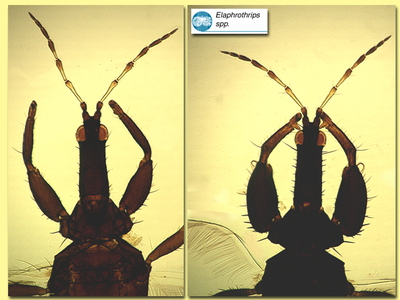Figures
Fig. 1 Antenna, head and thorax (right: male with enlarged fore femorae)Fig. 2 Tergite IV and V with wing retaining setae
Species
Elaphrothrips spp.
Biology
Feeding on fungal spores, and breeding on dead leaves and dead branches, and sometimes associated with the wooden supports on which orchids and cultivated. Large males often compete with smaller males for living and breeding space, and the range of variation in body structure between sexes and between large and small males within such species is confusing.
Distribution
More than 100 species are known, mainly from tropical countries.
Recognition
Head elongate, often prolonged in front of eyes; one pair of long setae near the ocelli, 1 pair of long postoculars; cheeks usually with a series of stout setae; maxillary stylets not deeply retracted into head, broad and band-like. Antennae 8-segmented. Fore tarsi of male, but not female, with stout tooth; external apical margin of fore femour of large males with a curved sickle-shaped seta in many species. Abdominal tergite I broad, usually with 3 lobes; median tergites with 2 pairs of sigmoid wing retaining setae; tergite IX setae long and pointed; tube without numerous lateral setae.
Related species
Species recognition amongst the many tropical species in this genus is difficult. In the eastern part of its range, including the tropical parts of Australia, the genus is replaced by Mecynothrips, in which the males have large horns on the thorax.



